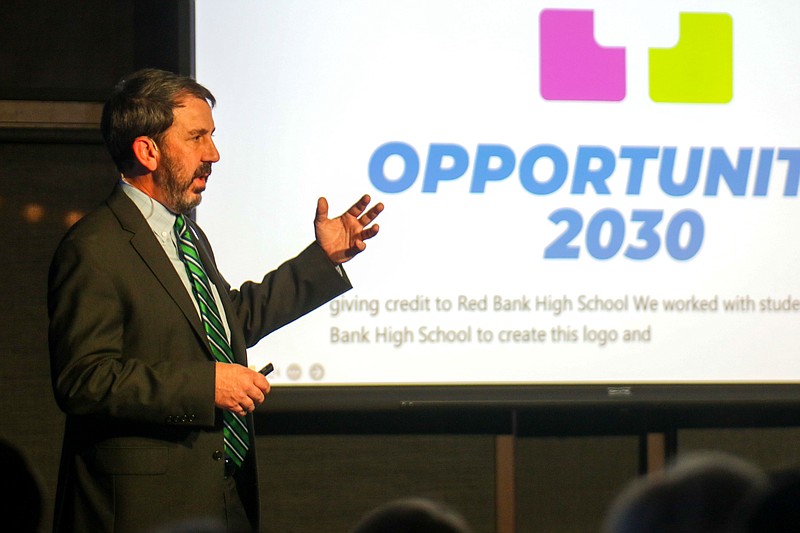The Hamilton County school district unveiled a new strategic plan Thursday evening at its annual State of the System event. The plan prioritizes student well-being, staffing support and community involvement.
The event was at a former Cigna office building that the district recently acquired for an elementary school in East Brainerd. Several student performances and speeches from local leaders including Hamilton County Mayor Weston Wamp, school board Chairwoman Tiffanie Robinson and Chattanooga 2.0 Executive Director Keri Randolph were featured.
Wamp, a Republican, stressed the importance of modern facilities, noting he and Superintendent Justin Robertson had convened a school facilities working group.
"And we've done that to explore how we can modernize the school facilities of this wonderful school system," Wamp said.
The mayor said he and the superintendent want to modernize facilities in a way that serves every student and doesn't stop at items like repairing leaky roofs.
Robinson, an independent from Chattanooga, said the school board looks forward to implementing the new plan.
"As all strong organizations evolve, we too must resist becoming complacent," Robinson said. "Our board is excited about new initiatives that center on the belief that all children can learn, a focus on student personalization, individualism and a sense of belonging."
The highlight of the evening was the district's new strategic plan, dubbed Opportunity 2030.
A strategic plan serves as a district's guide to what it hopes to achieve in the future. It lays out goals and milestones that can be adjusted and measured.
Robertson said as the previous strategic plan, Future Ready 2023, comes to an end, it's time for a holistic, community-centered approach to educating students.
"At the very center of this plan is the concept, the idea, that for us to do better, we have to serve students holistically," Robertson said."If we don't ensure that we're creating connections in the school and connections outside the community and serving the needs of students from that holistic approach, they're going to continue to struggle."
To achieve this, the plan is built around five pillars, or "commitments" to students, staff and the community:
-- Every Student Learns: Goals surrounding academic achievement.
-- Every Student Belongs: Goals to ensure students feel a sense of belonging and connectedness to their school.
-- Every School Equipped: Goals to improve facilities and equitable access to resources.
-- Every Employee Valued: Goals to ensure educators feel supported.
-- Every Community Served: Goals to involve more community members and organizations to support students.
"What we're committed to is closing gaps, to ensuring that we're creating opportunities for each and every student," Robertson said."When we're talking about 'every,' it's each and every. Each and every student. Each and every family. Each and every community right here in East Brainerd to the furthest tip in north Hamilton County."
Opportunity 2030 also describes who a Hamilton County graduate is through what's called a "Portrait of a Graduate."
"This is a significant change from the last strategic plan," Robertson said. "Essentially, this is our way of backward mapping. So, saying, if we want to get to where we're graduating these types of students, what do we need to do?"
Qualities of a future Hamilton County graduate include effective communication skills, cultural awareness and resiliency.
Officials said the plan has been in the making for more than a year and was created with feedback from students, staff and community members.
"There was a lot of community input here," Deputy Superintendent Sonia Stewart said in an interview. "We really engaged the business community to say, 'What are you looking for in a future workforce?' And just to reiterate, they don't talk standards at all in the business community. It's all these other competencies that they need in their workforce that they really wanted us to be intentionally focused on in a K-12 space."
Stewart added the plan addresses one main question: "Are our students well?"
"I think us taking that holistic approach, we know an educational institution cannot, in and of itself, make our children well," Stewart said. "It really is the community. It really is these outside connections, and so, how do we cultivate that collective responsibility for our children? Not just the ones that are in our houses, but the ones that are in our communities."
The plan also emphasizes teacher well-being and adds more support positions, including doubling the number of social workers in every building.
"We know that we have to do a better job of caring for our teachers and caring for our employees," Robertson said.
Middle Valley Elementary school counselor Donovan Davis said teaching has changed in the past few years.
"The landscape around education has drastically changed," Davis said during a presentation at Thursday's event. "If you haven't been in the classroom in the last three years, our current public education culture -- and time for a little bit of real talk -- is a toxic environment for most educators where we're feeling overwhelmed and under-supported."
School officials recently announced a new staffing model that infuses an additional $25 million to schools to hire behavior-focused staff members.
Though the district's budget has yet to be finalized by the state, officials said they're expecting $45 million more than the previous fiscal year, which totaled $456 million. They estimate that nearly $300 million of that will go toward school-based staffing.
Robertson said while the strategic plan does include aspects of social-emotional learning, the focus is serving students.
"There are a lot of things that we're not going to agree on, but I think one thing that we should all agree on is, are we serving our kids well?" Robertson said.
Contact Carmen Nesbitt at cnesbitt@timesfreepress.com or 423-757-6327.

